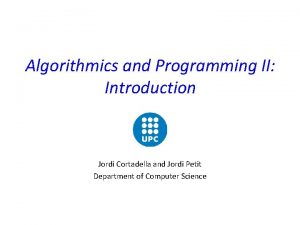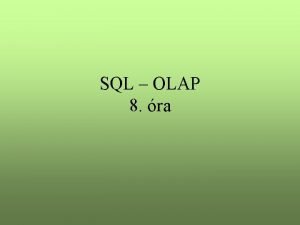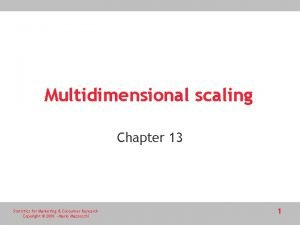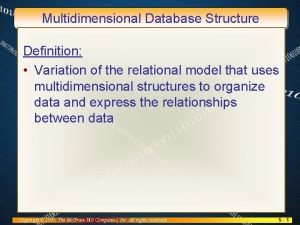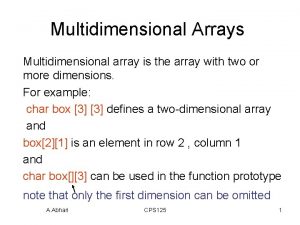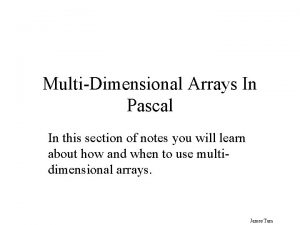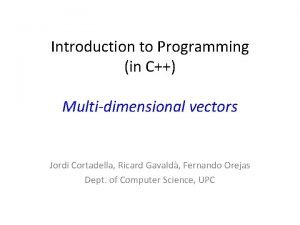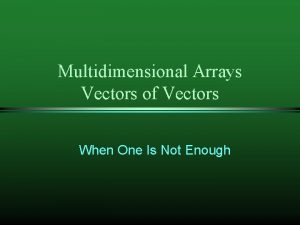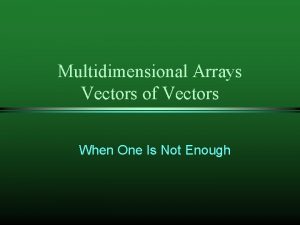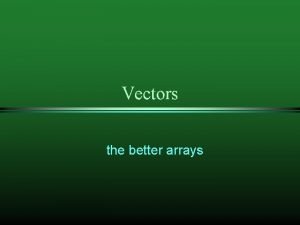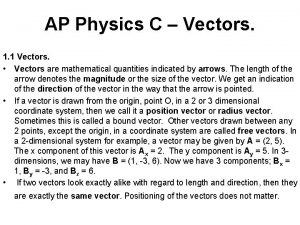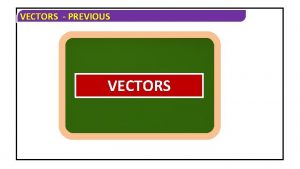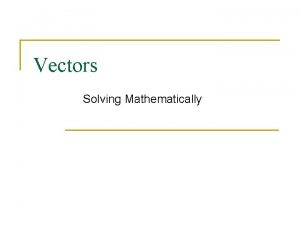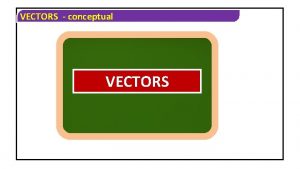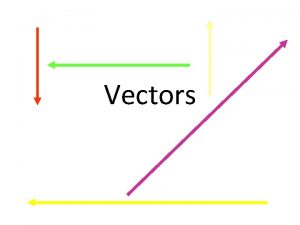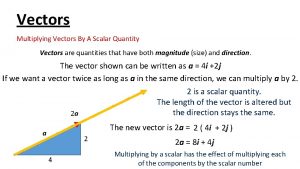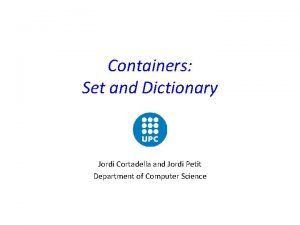Introduction to Programming in C Multidimensional vectors Jordi




























- Slides: 28

Introduction to Programming (in C++) Multi-dimensional vectors Jordi Cortadella, Ricard Gavaldà, Fernando Orejas Dept. of Computer Science, UPC

Matrices • A matrix can be considered a two-dimensional vector, i. e. a vector of vectors. my_matrix: 3 5 7 8 0 2 1 6 9 0 3 4 // Declaration of a matrix with 3 rows and 4 columns vector<int> > my_matrix(3, vector<int>(4)); // A more elegant declaration typedef vector<int> Row; // One row of the matrix typedef vector<Row> Matrix; // Matrix: a vector of rows Matrix my_matrix(3, Row(4)); Introduction to Programming // The same matrix as above © Dept. CS, UPC 2

Matrices • A matrix can be considered as a 2 -dimensional vector, i. e. , a vector of vectors. my_matrix: 3 5 7 8 0 2 1 6 9 my_matrix[0][2] 0 3 4 my_matrix[1][3] my_matrix[2] Introduction to Programming © Dept. CS, UPC 3

n-dimensional vectors • Vectors with any number of dimensions can be declared: typedef vector<int> Dim 1; vector<Dim 1> Dim 2; vector<Dim 2> Dim 3; vector<Dim 3> Matrix 4 D; Matrix 4 D my_matrix(5, Dim 3(i+1, Dim 2(n, Dim 1(9)))); Introduction to Programming © Dept. CS, UPC 4

Sum of matrices • Introduction to Programming © Dept. CS, UPC 5

How are the elements of a matrix visited? • By rows • By columns j j i i For every row i For every column j Visit Matrix[i][j] Introduction to Programming For every column j For every row i Visit Matrix[i][j] © Dept. CS, UPC 6

Sum of matrices (by rows) typedef vector<int> > Matrix; // Pre: a and b are non-empty matrices and have the same size. // Returns a+b (sum of matrices). Matrix matrix_sum(const Matrix& a, const Matrix& b) { int nrows = a. size(); int ncols = a[0]. size(); Matrix c(nrows, vector<int>(ncols)); for (int i = 0; i < nrows; ++i) { for (int j = 0; j < ncols; ++j) { c[i][j] = a[i][j] + b[i][j]; } } return c; } Introduction to Programming © Dept. CS, UPC 7

Sum of matrices (by columns) typedef vector<int> > Matrix; // Pre: a and b are non-empty matrices and have the same size. // Returns a+b (sum of matrices). Matrix matrix_sum(const Matrix& a, const Matrix& b) { int nrows = a. size(); int ncols = a[0]. size(); Matrix c(nrows, vector<int>(ncols)); for (int j = 0; j < ncols; ++j) { for (int i = 0; i < nrows; ++i) { c[i][j] = a[i][j] + b[i][j]; } } return c; } Introduction to Programming © Dept. CS, UPC 8

Transpose a matrix • Design a procedure that transposes a square matrix in place: void Transpose (Matrix& m); 3 8 1 0 6 2 4 5 9 3 0 4 8 6 5 1 2 9 • Observation: we need to swap the upper with the lower triangular matrix. The diagonal remains intact. Introduction to Programming © Dept. CS, UPC 9

Transpose a matrix // Interchanges two values void swap(int& a, int& b) { int c = a; a = b; b = c; } // Pre: m is a square matrix // Post: m contains the transpose of the input matrix void Transpose(Matrix& m) { int n = m. size(); for (int i = 0; i < n - 1; ++i) { for (int j = i + 1; j < n; ++j) { swap(m[i][j], m[j][i]); } } } Introduction to Programming © Dept. CS, UPC 10

Is a matrix symmetric? • Design a procedure that indicates whether a matrix is symmetric: bool is_symmetric(const Matrix& m); 3 0 4 0 6 5 4 5 9 3 0 4 0 6 5 4 2 9 symmetric not symmetric • Observation: we only need to compare the upper with the lower triangular matrix. Introduction to Programming © Dept. CS, UPC 11

Is a matrix symmetric? // Pre: m is a square matrix // Returns true if m is symmetric, and false otherwise bool is_symmetric(const Matrix& m) { int n = m. size(); for (int i = 0; i < n – 1; ++i) { for (int j = i + 1; j < n; ++j) { if (m[i][j] != m[j][i]) return false; } } return true; } Introduction to Programming © Dept. CS, UPC 12

Search in a matrix • Design a procedure that finds a value in a matrix. If the value belongs to the matrix, the procedure will return the location (i, j) at which the value has been found. // Pre: // Post: // // m is a non-empty matrix i and j define the location of a cell that contains the value x in m. In case x is not in m, then i = j = -1. void search(const Matrix& m, int x, int& i, int& j); Introduction to Programming © Dept. CS, UPC 13

Search in a matrix // Pre: // Post: // // m is a non-empty matrix i and j define the location of a cell that contains the value x in M. In case x is not in m, then i = j = -1 void search(const Matrix& m, int x, int& i, int& j) { int nrows = m. size(); int ncols = m[0]. size(); for (i = 0; i < nrows; ++i) { for (j = 0; j < ncols; ++j) { if (m[i][j] == x) return; } } i = -1; j = -1; } Introduction to Programming © Dept. CS, UPC 14

Search in a sorted matrix • A sorted matrix m is one in which m[i][j] m[i][j+1] m[i][j] m[i+1][j] 1 4 5 7 2 5 8 9 6 7 10 11 9 11 13 14 11 12 19 20 13 14 20 22 Introduction to Programming © Dept. CS, UPC 10 10 12 17 21 25 12 13 15 20 23 26 15

Search in a sorted matrix • Example: let us find 10 in the matrix. We look at the lower left corner of the matrix. • Since 13 > 10, the value cannot be found in the last row. 1 4 5 7 2 5 8 9 6 7 10 11 9 11 13 14 11 12 19 20 13 14 20 22 Introduction to Programming © Dept. CS, UPC 10 10 12 17 21 25 12 13 15 20 23 26 16

Search in a sorted matrix • We look again at the lower left corner of the remaining matrix. • Since 11 > 10, the value cannot be found in the row. 1 4 5 7 2 5 8 9 6 7 10 11 9 11 13 14 11 12 19 20 13 14 20 22 Introduction to Programming © Dept. CS, UPC 10 10 12 17 21 25 12 13 15 20 23 26 17

Search in a sorted matrix • Since 9 < 10, the value cannot be found in the column. 1 4 5 7 2 5 8 9 6 7 10 11 9 11 13 14 11 12 19 20 13 14 20 22 Introduction to Programming © Dept. CS, UPC 10 10 12 17 21 25 12 13 15 20 23 26 18

Search in a sorted matrix • Since 11 > 10, the value cannot be found in the row. 1 4 5 7 2 5 8 9 6 7 10 11 9 11 13 14 11 12 19 20 13 14 20 22 Introduction to Programming © Dept. CS, UPC 10 10 12 17 21 25 12 13 15 20 23 26 19

Search in a sorted matrix • Since 7 < 10, the value cannot be found in the column. 1 4 5 7 2 5 8 9 6 7 10 11 9 11 13 14 11 12 19 20 13 14 20 22 Introduction to Programming © Dept. CS, UPC 10 10 12 17 21 25 12 13 15 20 23 26 20

Search in a sorted matrix • The element has been found! 1 4 5 7 2 5 8 9 6 7 10 11 9 11 13 14 11 12 19 20 13 14 20 22 Introduction to Programming © Dept. CS, UPC 10 10 12 17 21 25 12 13 15 20 23 26 21

Search in a sorted matrix • Invariant: if the element is in the matrix, then it is located in the sub-matrix [0…i, j…ncols-1] j maybe here i not here Introduction to Programming © Dept. CS, UPC 22

Search in a sorted matrix // Pre: // // Post: // m is non-empty and sorted by rows and columns in ascending order. i and j define the location of a cell that contains the value x in m. In case x is not in m, then i=j=-1. void search(const Matrix& m, int x, int& i, int& j) { int nrows = m. size(); int ncols = m[0]. size(); i = nrows - 1; j = 0; // Invariant: x can only be found in M[0. . i, j. . ncols-1] while (i >= 0 and j < ncols) { if (m[i][j] < x) j = j + 1; else if (m[i][j] > x) i = i – 1; else return; } i = -1; j = -1; } Introduction to Programming © Dept. CS, UPC 23

Search in a sorted matrix • What is the largest number of iterations of a search algorithm in a matrix? Unsorted matrix Sorted matrix nrows × ncols nrows + ncols • The search algorithm in a sorted matrix cannot start in all of the corners of the matrix. Which corners are suitable? Introduction to Programming © Dept. CS, UPC 24

Matrix multiplication • Design a function that returns the multiplication of two matrices. 2 -1 0 1 1 3 2 0 × 1 3 -1 2 2 0 1 -1 -1 2 3 4 = 1 8 3 0 4 11 // Pre: a is a non-empty n×m matrix, // b is a non-empty m×p matrix // Returns a×b (an n×p matrix) Matrix multiply(const Matrix& a, const Matrix& b); Introduction to Programming © Dept. CS, UPC 25

Matrix multiplication // Pre: a is a non-empty n×m matrix, b is a non-empty m×p matrix. // Returns a×b (an n×p matrix). Matrix multiply(const Matrix& a, const Matrix& b) { int n = a. size(); int m = a[0]. size(); int p = b[0]. size(); Matrix c(n, vector<int>(p)); for (int i = 0; i < n; ++i) { for (int j = 0; j < p; ++j) { int sum = 0; for (int k = 0; k < m; ++k) { sum = sum + a[i][k] b[k][j]; } c[i][j] = sum; } } return c; } Introduction to Programming © Dept. CS, UPC 26

Matrix multiplication // Pre: a is a non-empty n×m matrix, b is a non-empty m×p matrix. // Returns a×b (an n×p matrix). Matrix multiply(const Matrix& a, const Matrix& b) { int n = a. size(); Initialized int m = a[0]. size(); to zero int p = b[0]. size(); Matrix c(n, vector<int>(p, 0)); for (int i = 0; i < n; ++i) { for (int j = 0; j < p; ++j) { for (int k = 0; k < m; ++k) { c[i][j] += a[i][k] b[k][j]; } } } return c; } Introduction to Programming The loops can be in any order Accumulation © Dept. CS, UPC 27

Matrix multiplication // Pre: a is a non-empty n×m matrix, b is a non-empty m×p matrix. // Returns a×b (an n×p matrix). Matrix multiply(const Matrix& a, const Matrix& b) { int n = a. size(); int m = a[0]. size(); int p = b[0]. size(); Matrix c(n, vector<int>(p, 0)); for (int j = 0; j < p; ++j) { for (int k = 0; k < m; ++k) { for (int i = 0; i < n; ++i) { c[i][j] += a[i][k] b[k][j]; } } } return c; } Introduction to Programming © Dept. CS, UPC 28
 Jordi reviriego
Jordi reviriego Jordi ustrell
Jordi ustrell Jordi benlliure
Jordi benlliure Language telegram
Language telegram Jordi juanico sabate
Jordi juanico sabate Jordi timmers
Jordi timmers Jordi ayala
Jordi ayala Jordi vives i batlle
Jordi vives i batlle Jordi garcia cehic
Jordi garcia cehic Jordi graells costa
Jordi graells costa Jordi npa
Jordi npa Jordi scene
Jordi scene Jordi vives i batlle
Jordi vives i batlle Strongly connected components
Strongly connected components Jordi olivares
Jordi olivares Jordi gisbert
Jordi gisbert Jordi sastre
Jordi sastre Turing machine
Turing machine Multidimensional expressions
Multidimensional expressions Multidimensional scaling in marketing
Multidimensional scaling in marketing Multidimensional model of leadership
Multidimensional model of leadership Multidimensional databases
Multidimensional databases Multidimensional database management system
Multidimensional database management system Multidimensional array
Multidimensional array Arrays in pascal
Arrays in pascal Multidimensional space in data mining
Multidimensional space in data mining Reading rate by grade level
Reading rate by grade level Multidimensional vector c++
Multidimensional vector c++ Index
Index



